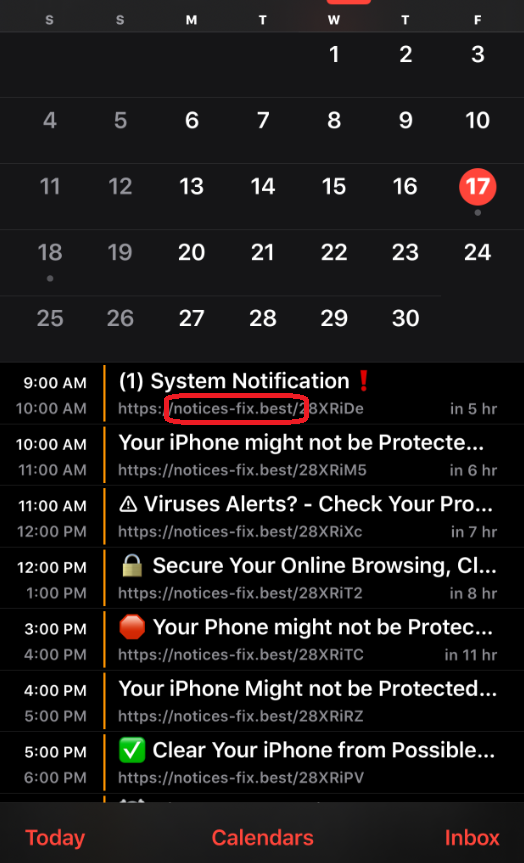Notices Fix Best
Notices Fix Best is an iPhone browser hijacker that is programmed to fill the device’s screen with obstructive pop-ups and to redirect the user while they are browsing. Notices Fix Best usually spreads by being attached to another app and getting installed alongside it.

The Notices Fix Best Virus will fill you calendar with annoying ads.
Usually, browser hijackers are more common for Android and Windows PC users, but it’s still possible to get them on Apple products such as Macs and iPhones. Notices Fix Best, in particular, is designed as an iPhone/iPad hijacker and if you are seeing obstructive pop-ups or banners on your iPhone’s screen and if your Chrome or Safari browsing sessions are constantly getting redirected to unknown sites, then you most likely have the unwanted app. Another sign of infection is a changed browser homepage and/or search engine.
If the hijacker is in your device, then it is highly recommended that you take a look at the removal guide posted below and use it to uninstall the invasive app. Despite not being particularly harmful themselves, the content and sites promoted by apps like Notices Fix Best could oftentimes be unsafe. Many fake or virus-distributing sites use the services provided by hijackers such as this one in order to reach more users and infect them with Trojans, Ransomware, and Spyware or to collect sensitive user data through phishing forms. Because of this, you should uninstall the hijacker at once if it is on your iPhone.
Also, to ensure you don’t get any more such apps in the future, only use the App Store when downloading new apps and even then make sure that the app is from а reputed developer and that the reviews from other users are good. This should dramatically decrease the chances of downloading an application that has a built-in browser hijacker.
Notices Fix Best iPhone Removal
If you have an iPhone virus, continue with the guide below.
If you have an Android virus, please use our Android Malware Removal guide.
If you have a Mac virus, please use our How to remove Ads on Mac guide.
If you have a Windows virus, please use our Windows Virus Removal guide.
This is the first thing you should try if you are getting targeted by this kind of spam.
- Log in yo your account at iCloud.com and tap on Calendar.
- Tap on the Settings icon (a gear icon) located in the lower-left corner of the screen.
- Now, select Preferences and then Advanced.
- Change the Invitations setting from In-app notifications to Email to and provide your current email.
- Lastly, click on Save to confirm the change.
Note that after you do that, you will no longer get any events automatically added to your Calendar. Instead, they’d go to the email you have provided. This also applies to the spam you’ve been getting – it would too go to your email, but at least you won’t be getting the spam notifications on your screen.
The next part of this post will tell you how to check your iPhone for an actual Calendar spam virus and how to deal with such a virus if it gets detected.
To remove Calendar Virus quickly you can try this:
1. Go to Settings on your iPhone/iPad.
2. Open Passwords and Accounts.
3. Then go to Subscribed Calendars.
4. Look for anything that looks suspicious and delete it.
First you need to close all pop-ups that are currently open.
- If the pop-up has a checkbox named “Don’t show more alerts from this webpage” click on the checkbox before closing the Ad.
- If a Block Alerts button happens to appear after you shut down a pop-up on your iPhone, iPad, or iPod touch tab that button to stop receiving alerts from the same page.
In case that a pop-up fails to close after performing the above operations:
- On your Mac you should make your Safari browser close forcibly by pressing Command-Option-Esc. Select Safari from the list of Apps and force close it. After you force close it you need to restart Safari, but please hold the shift button while it starts. This will prevent any pesky Ads from opening automatically.
- On your iPhone, iPad, or iPod touch you can do the same by pressing the home button twice in a quick succession. You’ll then see a preview of all apps that have been recently used. Swipe left to find Safari and then swipe up on the app’s preview to close it forcibly In order to prevent Safari from opening unwanted windows on startup go to Settings->Safari and Clear History, as well as Website Data. This will also clear your browser history and cookies so keep that in mind and export them if you want to keep them.
Choose Preferences from the Safari menu. Then do the following:
- Select the Security icon and then click on “Block pop-up windows“. This should stop many types of pop-ups from appearing.
- Next check on your homepage and the settings for the search engines. Adware likes messing with those. We can not provide more specific instructions for this, as you may be using many different browsers.
- Select the General icon and look at the Homepage field. It should either be empty or filled with the address of the Homepage you want.
- Follow up on the Search icon. Again it should be either the default search engine or any that you have set for yourself. Note that in some versions of Safari these settings are found in the General panel/
Open Safari and click on the Extensions button. Note that Adware use extensions almost exclusively to inject the pop-up Ads into your browser. Any extension on this list that you do not remember installing yourself is likely planted there by the Adware. Remove ALL extensions you are unfamiliar with.
Leave a Comment X